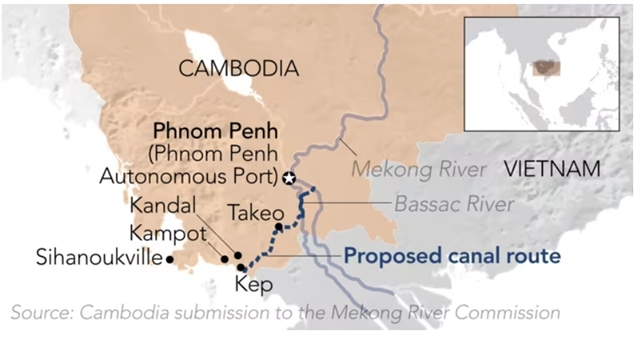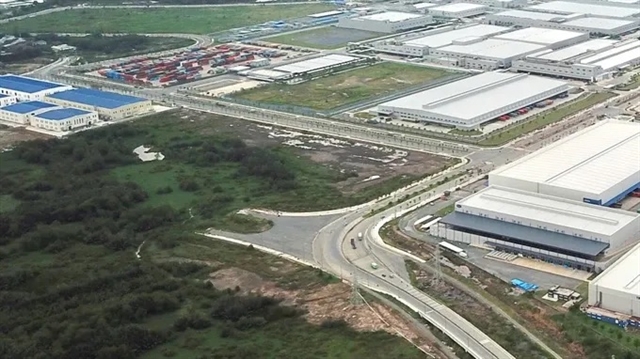 Environment
Environment

 |
| Overview of Funan Techo Canal project, submitted by Cambodia to the Mekong River Commission. Photo courtesy of the Mekong River Commission |
BẾN TRE – Localities in the Mekong River basin sub-region need to prepare proactive scenarios and solutions to address the reduction in water resources and other impacts once Cambodia's Funan Techo canal project is built, experts have said.
The Funan Techo canal project, approved by the Cambodian Cabinet in May 2023, connects the capital city Phnom Penh with the Gulf of Thailand in Cambodia's southern coast near Kiên Giang Province in Việt Nam.
The US$1.7-billion canal will be approximately 180km long, passing through four provinces with a total population of 1.6 million people living on both sides.
The project is expected to have a width of 100m upstream and 80m downstream, with a depth of 5.4m, allowing cargo ships with a total load of up to 3,000 tonnes to pass during the dry season and 5,000 tonnes during the rainy season.
The canal, built by Chinese businesses under a Build-Operate-Transfer model, is expected to begin construction at the end of this year and be operational by 2028.
According to experts, the formation of the Funan Techo Canal will have a negative impact on the region, causing water shortages and increasing salinisation in the already parched Mekong Delta.
Currently, a detailed, specific assessment of the project's impact has yet to be clearly published.
Four years to prepare response measures
According to experts, the most affected and vulnerable localities in the Mekong Delta sub-region will be those along the Tiền and Hậu Rivers, such as An Giang, Đồng Tháp, Tiền Giang, Bến Tre, Vĩnh Long, Trà Vinh, Cần Thơ, Hậu Giang and Sóc Trăng.
In fact, this year's dry season has already seen prolonged droughts, with the water levels in the upper Mekong River significantly reduced due to upstream dams storing water. Saltwater intrusion has penetrated further inland than the multi-year average, marking one of the most severe drought and salinity seasons in history.
Given the increasingly unpredictable nature of climate change and the reduction in freshwater availability, the construction of the Funan Techo canal will likely exacerbate severe drought and salinity issues in the Mekong Delta in the future.
They stress that these localities have four years to prepare for response plans.
Lữ Quang Ngời, Chairman of the Vĩnh Long Provincial People's Committee, told Tiền Phong (Vanguard) that when a river is intersected by a canal project, the downstream region would inevitably be affected.
However, there was currently no specific and accurate information on the impact of the Funan Techo canal project on the Mekong Delta.
"Our locality has only recently received information from scientists through the media, and the public is also concerned and anxious. However, no directives have been issued regarding what actions the locality should take, so we are still waiting for more information," Ngời said.
He noted that even without specific information about Cambodia's canal project, there were already other factors affecting water resources in the region.
Following the Prime Minister's directives, Vĩnh Long Province has implemented several solutions. The local authorities have regularly informed the public to proactively adapt to climate change and ensure water resources for daily use and production.
However, some measures are beyond the locality's capacity, necessitating support and cooperation from the central government and the entire region, according to Ngời.
 |
| A dried up melon cultivation in Long An Province. VNA/VNS Photo |
Trà Vinh Provincial People's Committee Chairman Lê Văn Hẳn emphasised the province's concern about the Funan Techo canal project, as localities along the Mekong River would be directly affected.
Hẳn said Trà Vinh planned to review and convene relevant departments to propose and recommend actions to the central government.
"If the project proceeds, the Mekong Delta localities, including Trà Vinh, will need to develop solutions at the provincial and regional levels," Hẳn suggested.
Bùi Văn Thắm, Deputy Director of the Department of Agriculture and Rural Development of Bến Tre Province, stated that Bến Tre, located at the end of the Mekong River region, is impacted by climate change and upstream water regulation activities such as hydropower dams and the Funan Techo canal.
"Whether we like it or not, we have to devise response solutions. Bến Tre is currently improving its irrigation system and constructing sluices and embankments. It is expected that by 2028, the Ministry of Agriculture and Rural Development will complete the sluices for the water management project, which will fundamentally secure the province's protective embankments," Thắm said.
He emphasised that Bến Tre could not be isolated from the solutions for the entire Mekong Delta region. While Bến Tre could implement local defensive measures, at the regional level, scientists and central agencies needed to research new models for water resources management.
Thắm added: "When the Funan Techo canal and upstream Mekong hydropower dams are established, what will the new water model for the entire Mekong Delta look like? What direction will it take? We need to map this out to properly allocate and plan residential areas and production zones to minimise the negative impacts of freshwater shortages."
He said that even though residents had adapted to saline intrusion, the situation could change significantly with the Funan Techo canal. Therefore, it was essential to have research, assessments, and comprehensive solutions for each province and the region.
Commenting on the response to the canal, Professor Võ Tòng Xuân suggested that it was necessary to reinforce the canal system in the Long Xuyên Quadrangle. Initially, existing canals should be dredged to increase their depth and capacity to store water from the Vàm Nao River, coupled with anti-erosion embankments and the construction of additional freshwater reservoirs.
This way, freshwater would reach Thoại Sơn and Núi Sập in An Giang Province and extend to Hòn Đất in Kiên Giang Province. The canal system in the Đồng Tháp Mười region was nearly complete and would require only further reinforcement.
At a conference on May 9, spokeswoman for the foreign ministry Phạm Thu Hằng asked Cambodia to closely coordinate with Việt Nam and other countries in the Mekong River Commission (MRC) to fully share information to understand more in-detail impacts of the planned megaproject Funan Techo Canal.
Previously, Cambodian Deputy Prime Minister Sun Chanthol stated that the project would only require 5 cu.m of water per second, equivalent to 0.053 per cent of the river flow, and that the canal could even contribute to reducing floods in southern Việt Nam. VNS




